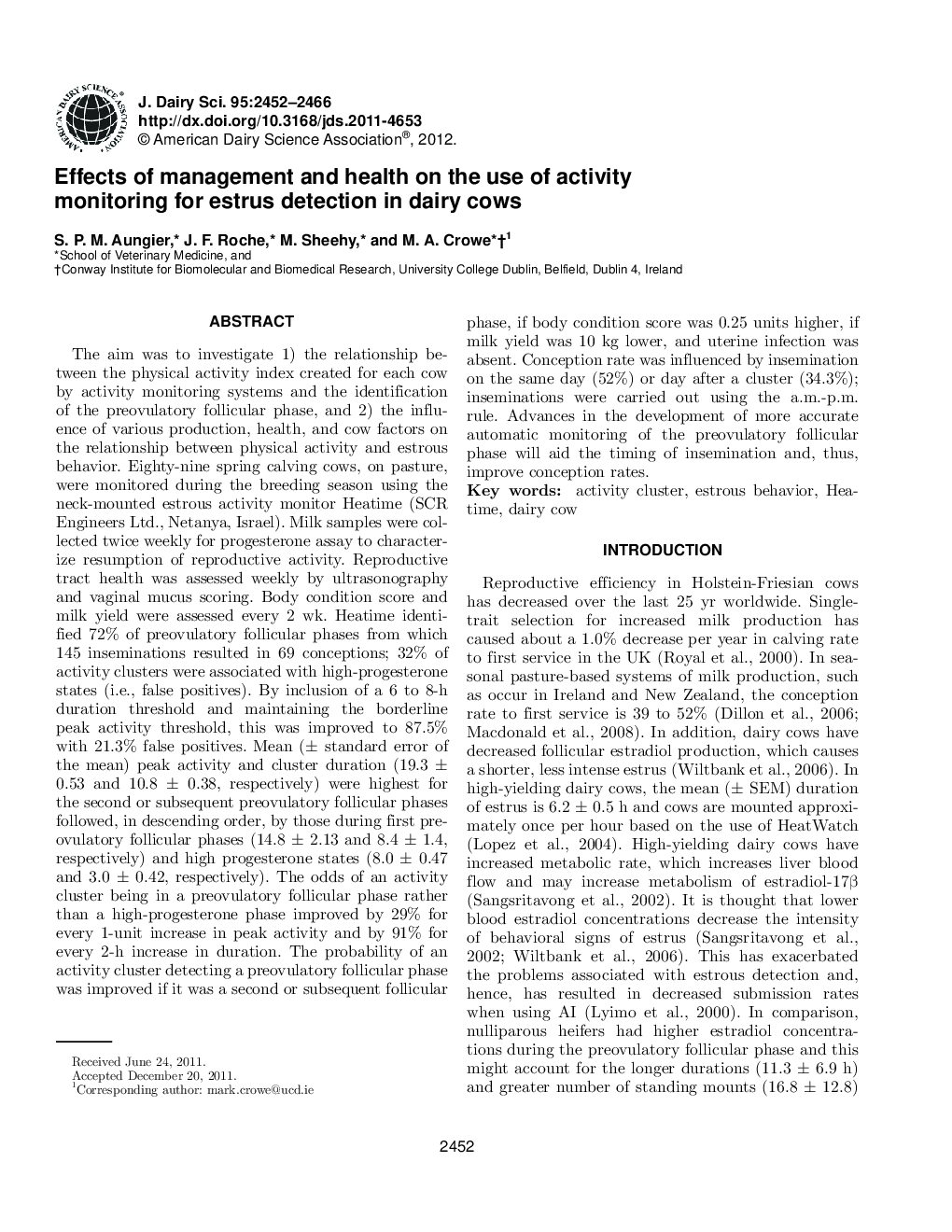| کد مقاله | کد نشریه | سال انتشار | مقاله انگلیسی | نسخه تمام متن |
|---|---|---|---|---|
| 10980198 | 1108069 | 2012 | 15 صفحه PDF | دانلود رایگان |
عنوان انگلیسی مقاله ISI
Effects of management and health on the use of activity monitoring for estrus detection in dairy cows
دانلود مقاله + سفارش ترجمه
دانلود مقاله ISI انگلیسی
رایگان برای ایرانیان
موضوعات مرتبط
علوم زیستی و بیوفناوری
علوم کشاورزی و بیولوژیک
علوم دامی و جانورشناسی
پیش نمایش صفحه اول مقاله

چکیده انگلیسی
The aim was to investigate 1) the relationship between the physical activity index created for each cow by activity monitoring systems and the identification of the preovulatory follicular phase, and 2) the influence of various production, health, and cow factors on the relationship between physical activity and estrous behavior. Eighty-nine spring calving cows, on pasture, were monitored during the breeding season using the neck-mounted estrous activity monitor Heatime (SCR Engineers Ltd., Netanya, Israel). Milk samples were collected twice weekly for progesterone assay to characterize resumption of reproductive activity. Reproductive tract health was assessed weekly by ultrasonography and vaginal mucus scoring. Body condition score and milk yield were assessed every 2 wk. Heatime identified 72% of preovulatory follicular phases from which 145 inseminations resulted in 69 conceptions; 32% of activity clusters were associated with high-progesterone states (i.e., false positives). By inclusion of a 6 to 8-h duration threshold and maintaining the borderline peak activity threshold, this was improved to 87.5% with 21.3% false positives. Mean (± standard error of the mean) peak activity and cluster duration (19.3 ± 0.53 and 10.8 ± 0.38, respectively) were highest for the second or subsequent preovulatory follicular phases followed, in descending order, by those during first preovulatory follicular phases (14.8 ± 2.13 and 8.4 ± 1.4, respectively) and high progesterone states (8.0 ± 0.47 and 3.0 ± 0.42, respectively). The odds of an activity cluster being in a preovulatory follicular phase rather than a high-progesterone phase improved by 29% for every 1-unit increase in peak activity and by 91% for every 2-h increase in duration. The probability of an activity cluster detecting a preovulatory follicular phase was improved if it was a second or subsequent follicular phase, if body condition score was 0.25 units higher, if milk yield was 10 kg lower, and uterine infection was absent. Conception rate was influenced by insemination on the same day (52%) or day after a cluster (34.3%); inseminations were carried out using the a.m.-p.m. rule. Advances in the development of more accurate automatic monitoring of the preovulatory follicular phase will aid the timing of insemination and, thus, improve conception rates.
ناشر
Database: Elsevier - ScienceDirect (ساینس دایرکت)
Journal: Journal of Dairy Science - Volume 95, Issue 5, May 2012, Pages 2452-2466
Journal: Journal of Dairy Science - Volume 95, Issue 5, May 2012, Pages 2452-2466
نویسندگان
S.P.M. Aungier, J.F. Roche, M. Sheehy, M.A. Crowe,